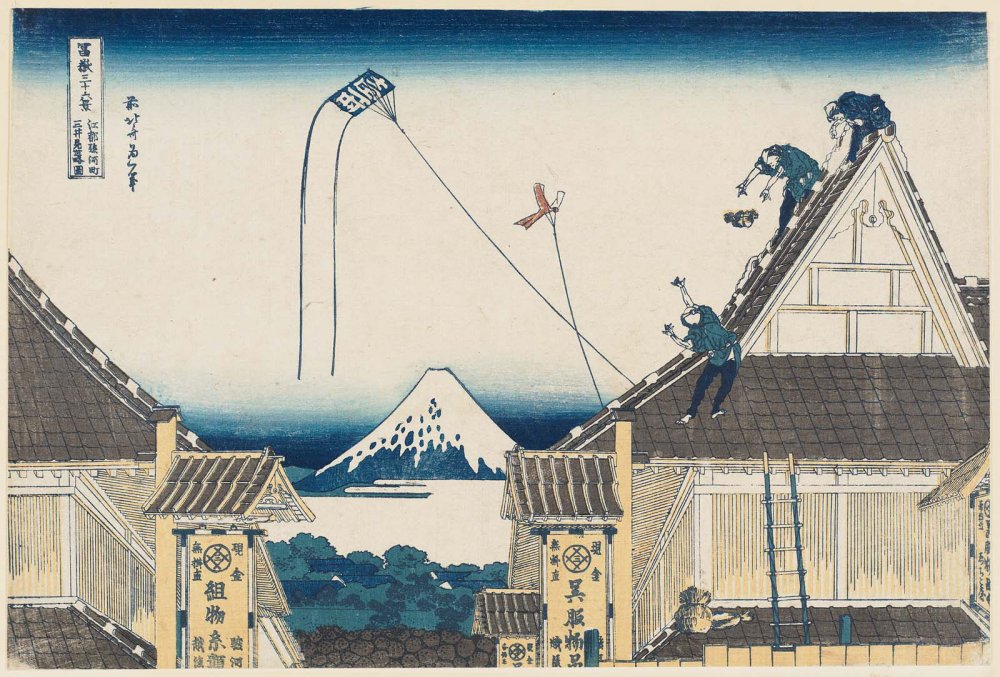| |
HOKUSAI(1760 - 1849)"View of the Mitsui Stores at Surugachō in Edo" |

"View of the Mitsui Stores at
Surugachō in Edo"
("
江都駿河町三井見世略図", "Kōto Suruga-chō Mitsui Miseryakuzu")
Series: "Thirty-six Views of Mount Fuji" (series number: 21)
("富嶽三十六景", Fugaku Sanjūrokkei)
Takamizawa Reprint 1919
Comment - View of the the Echigoya
Mitsui Clothing Store at Surugacho in Downtown Edo with the impressive Mitsui
family merchant buildings lining the prosperous street. A blue
Edo kite ("Edo-tako",
"江戸凧") floates in a slow breeze, with it's long tails nearly
vertically hanging down. The Kanji
("Kanji kite", "ji tako", "字凧") indicating this special
occasion (congratulating for the opening of the store). A
reddish brown Bird-of prey kite
("tonbi dako", "鳶凧") is flying near to the Edo-tako. Both
kites framing Mount Fuji in the distance. Kiting is a
traditional pasttime for New Year, with the kites both showing
it's New Year's Day. Mount Fuji was closely connected with New
Year's festivities, and a dream of the mountain at this time
was especially auspicious. The scene closely reminds the
composition of HOKUSAI's "Asakusa Hongan-ji
temple in the Eastern capital" from the same series.
The Mitsui Clothing Store just north of Nihonbashi (Japan Bridge) was the predecessor of modern Mitsukoshi, the largest department store in Japan. By HOKUSAI’s time, the store had adopted an innovative business practice of expecting cash payment at the time of sale, which allowed them to establish low, fixed prices. The street is flanked with two Mitsui stores, each with a sign stating "Clothing" (right) and "Braided Cords and Threads" (left). Accordingly, the signs to either side read "Cash Payment" and "No Padded Prices". By abandoning the traditional system of customer accounts paid only a few times each year, the Mitsui Family was able to build one of the most successful financial empires in twentieth century Japan. Different kinds of Mitsui enterprises have been depicted in kite woodblock prints by Hokusai (see above), Hiroshige-III and Kuniyoshi.
Surugachō was famous for its fine views of Mount Fuji. In this print, HOKUSAI has cropped the foreground and used a high viewing angle to eliminate details of the street, thereby establishing Mount Fuji as the main subject. Its form is repeated in the roof of the store, which is being repaired by three workmen.
Series - The series "Thirty-six Views of Mount Fuji" ("富嶽三十六景", Fugaku Sanjūrokkei) includes some of HOKUSAI's greatest masterpieces. These fantastic images portray the strength and majesty of nature, leading the viewer to contemplate man's place in relation to the natural world. The series "Thirty-six Views of Mount Fuji" justly remains HOKUSAI's most famous and highly regarded work.
Artist - see Biography
Signature - Zen HOKUSAI tame hitofude ("前北斎為一筆", "previously drawn by HOKUSAI")
Publisher - Takamizawa Mokuhansha (高見沢木版社); (Reprint 1919)
Image Size - 15.2 x 20.3 cm (10 1/8" x 15") + margins as shown)
Condition - Woodblock print (nishiki-e); ink and color on paper, single sheet, horizontal ôban; Yoko-e ('landscape')
The Mitsui Clothing Store just north of Nihonbashi (Japan Bridge) was the predecessor of modern Mitsukoshi, the largest department store in Japan. By HOKUSAI’s time, the store had adopted an innovative business practice of expecting cash payment at the time of sale, which allowed them to establish low, fixed prices. The street is flanked with two Mitsui stores, each with a sign stating "Clothing" (right) and "Braided Cords and Threads" (left). Accordingly, the signs to either side read "Cash Payment" and "No Padded Prices". By abandoning the traditional system of customer accounts paid only a few times each year, the Mitsui Family was able to build one of the most successful financial empires in twentieth century Japan. Different kinds of Mitsui enterprises have been depicted in kite woodblock prints by Hokusai (see above), Hiroshige-III and Kuniyoshi.
Surugachō was famous for its fine views of Mount Fuji. In this print, HOKUSAI has cropped the foreground and used a high viewing angle to eliminate details of the street, thereby establishing Mount Fuji as the main subject. Its form is repeated in the roof of the store, which is being repaired by three workmen.
Series - The series "Thirty-six Views of Mount Fuji" ("富嶽三十六景", Fugaku Sanjūrokkei) includes some of HOKUSAI's greatest masterpieces. These fantastic images portray the strength and majesty of nature, leading the viewer to contemplate man's place in relation to the natural world. The series "Thirty-six Views of Mount Fuji" justly remains HOKUSAI's most famous and highly regarded work.
Artist - see Biography
Signature - Zen HOKUSAI tame hitofude ("前北斎為一筆", "previously drawn by HOKUSAI")
Publisher - Takamizawa Mokuhansha (高見沢木版社); (Reprint 1919)
Image Size - 15.2 x 20.3 cm (10 1/8" x 15") + margins as shown)
Condition - Woodblock print (nishiki-e); ink and color on paper, single sheet, horizontal ôban; Yoko-e ('landscape')
Copyright 2008 ff: Hans P. Boehme